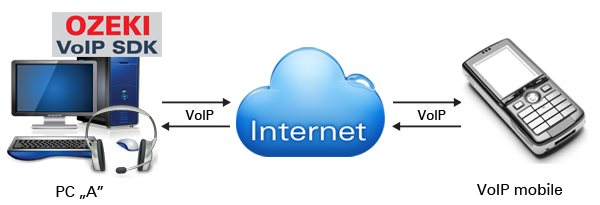VoIP technology
Voice over Internet Protocol (VoIP) is a form of telecommunication where conversation travels through the Internet (or other IP-based data network) instead of the traditional telephoning system. For its many practical reasons, VoIP is a trending technology nowadays, which spreads in wider and wider circles all around the world. Although, VoIP itself is relatively new (invented in 1994), it will soon bring a revolution in our everyday telecommunication. It already is in common use in the business sphere.

Introduction
By following these links, you will find all the basic knowledge you need to learn related to VoIP technology. Get to know everything about the elementary technical background, the different connection types, and the various fields of use of VoIP. These can be important if you would like to dig deeper in this subject and also if you would like to use our excellent VoIP SIP SDK for building various VoIP solutions.
Define VoIP
Take a look at the greatest advantages of VoIP technology to find out how you can benefit from the Internet-based communication. Read more
Get to know how to create your own VoIP solution in your local network environment by using Ozeki VoIP SIP SDK. Read more
Learn how to communicate with your customers and other external partners by building VoIP technology in WAN environment. Read more
Find out how to communicate with those of your partners who still use PSTN landline network instead of VoIP. Read more
Due to the mobile VoIP technology, any mobile phone can be used as the part of your VoIP network. Let's see how. Read more
Network entities
Ozeki VoIP SIP SDK can be used to build phone systems. Discover the advantages of using an IP PBX instead of an analog one. Read more
This SDK can be also used to implement advanced corporate phone systems to serve business communication needs. Read more
Study the physical VoIP phones that can be easily connected to the communication network allowing VoIP telephony simply. Read more
Get to know all of the telephone adapters which you can meet with during the configuration of your VoIP communication network. Read more
Softphones are most commonly used to make phone calls over the Internet. It is also possible to create softphones with this SDK. Read more
SIP accounts are needed while configuring your VoIP network. Find out all the essential terms related to this topic. Read more
This guide provides a detailed explanation on why it is worth to use VoIP, IP and SIP phone lines rather than other lines. Read more
Get more basic information about audio and video phone calls and data transmissions made through SIP protocol. Read more
Learn more about ATA devices that enable you to connect traditional analog telephones to your VoIP network efficiently. Read more
A VoIP call center development is based on a server-client solution. Get more information about its server-side. Read more
This article introduces the client-side of a VoIP call center that is based on a server-client solution. Read more
Protocols
Learn about Session Initiation Protocol (SIP) that can be used to create, modify and terminate two-party or multiparty sessions. Read more
The following RFC documents defines those standard protocols that are needed to be able to make VoIP calls. Read more
- RFC 2833
- RFC 3261
- RFC 3263
- RFC 3264
- RFC 3265
- RFC 3420
- RFC 3428
- RFC 3489
- RFC 3515
- RFC 3550
- RFC 3551
- RFC 3587
- RFC 3666
- RFC 3725
- RFC 3842
- RFC 3856
- RFC 3891
- RFC 3892
- RFC 3920
- RFC 4566
- RFC 5411
Get more information about the User Datagram Protocol (UDP) that is used for data transferring in VoIP technology. Read more
This page presents SDP (Session Description Protocol) that conveys information on media streams in multimedia sessions. Read more
Get to know the Real-time Transport Protocol (RTP) that defines a standardized packet format for multimedia data transmission. Read more
RTCP (Real-Time Transport Control Protocol) is a companion protocol of the RTP that is used to send/receive most media over IP. Read more
This article introduces the H323 protocol that gives a foundation for audio, video and data communications over the Internet. Read more
